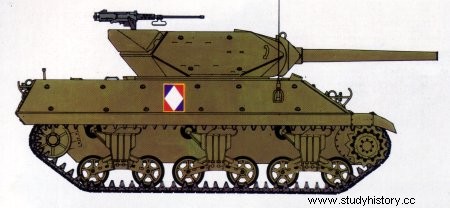
M10 "Tank Destroyer"
Country:USA
Type:tank destroyer.
Crew:5 men.
Armament:one 3-inch M7 cannon; a .50 M2 anti-aircraft machine gun.
Shielding:minimum 12.7 mm;
max 50.8mm.
Dimensions:
length:5.97m;
width:3.05 m;
height:2.48 m.
Weight in combat order:29.9 t.
Ground pressure:0.95 kg/cm2.
Mass power:12.7 hp/t.
Engine:2 General Motors 6-71 6 cyl. water-cooled diesels, developing a total of 375 hp at 2,100 rpm.
Performance:
road speed:48 km/h;
off-road speed:32 km/h;
autonomy on the road:320 km/h;
vertical obstacle:0.61 m;
straight cut:2.29 m;
60% slope.
Service time:introduced in the American army in 1942. Also used intensively by the Allies - especially the British army - during the Second World War, it remained in service after the conflict.
In June 1942, a modified T35E1 was adopted and designated M10 3 inch Gun Motor Carriage. The name of" . Wolverine (glutton) was sometimes used for this vehicle. The M10 was a good combat machine with a relatively low silhouette and a decent ballistic profile. Ports on vulnerable surfaces allowed additional armor to be laid, but this method does not appear to have been used often.
The M10 also had its flaws. The open turret left the crew (and some of the ammunition) exposed to shrapnel and air attack, and the very massive 3-inch gun cluttered the turret - and that was only a lesser evil, because it also unbalanced it. The piece fired a capped armor-piercing shell, at the maximum range of 14,631 m, with an initial speed of 792 m/s and which penetrated at 900 m, 102 mm of hardened armor on the surface.
However, as it was derived from an anti-aircraft weapon, the barrel took up a lot of space; virtually nothing had been done to remedy it; as a result, the length and weight of the tube required a counterweight of 1,134 kg to balance the turret and allow it to swivel in azimuth by manual control. The M10A1 was authorized to use the chassis of the M4A3 but, apart from the disappearance of the Ford GAA engine, there was no notable difference. Production of the M10 and M10A1 reached a total of 6,346 units.
Most M10A1s were kept on US soil or lost their turrets to become M35 tractors, assigned to the 240mm howitzer and 8-inch guns. The British Army was to replace, in many cases, the original M7 gun with its 17-pounder. The machine resulting from this conversion bore the name of Achilles and showed indisputably superior efficiency. The Achilles remained in service with the Royal Artillery well into the post-war period and the Royal Danish Army was still using it until recently.
The 3-inch M7 gun dated back at least to 1918 and if it wasn't really outdated, it didn't let; at the very least, very little room for possible improvements.
In September 1942, a commission of inquiry set out to establish whether the 90 mm anti-aircraft gun, then being developed for use on armor and anti-tank missions, could be adapted to the turret of the M10.
This was achieved by designing a new turret and the M10 became the T71 90mm Gun Motor Carriage. However, it took nearly two years for the 90 mm gun to reach front-line units, while the lack of anti-tank means in the European theater of operations caused serious concern.
Five hundred T71s were ordered in November 1943 and 300 of them were taken directly from M10 production. The T7 gun (the M1 anti-aircraft piece modified to be mounted on the 3-inch mount) was standardized in August 1943 under the designation of 90 mm M3.
In June 1944, the T71 was standardized under the designation of M36 90 mm Gun Motor Carnage and the production, started with the "limited order" of the 500 specimens mentioned above, continued with the first machines arriving on the front in July 1944.
The M6 used the same hull as the R10A1, but manufacturing difficulties led to trials of a device that mounted the M36 turret on the hull of the standard M4A3 tank.
